Bird R.B., Stewart W.E., Lightfoot E.N. Transport Phenomena
Подождите немного. Документ загружается.

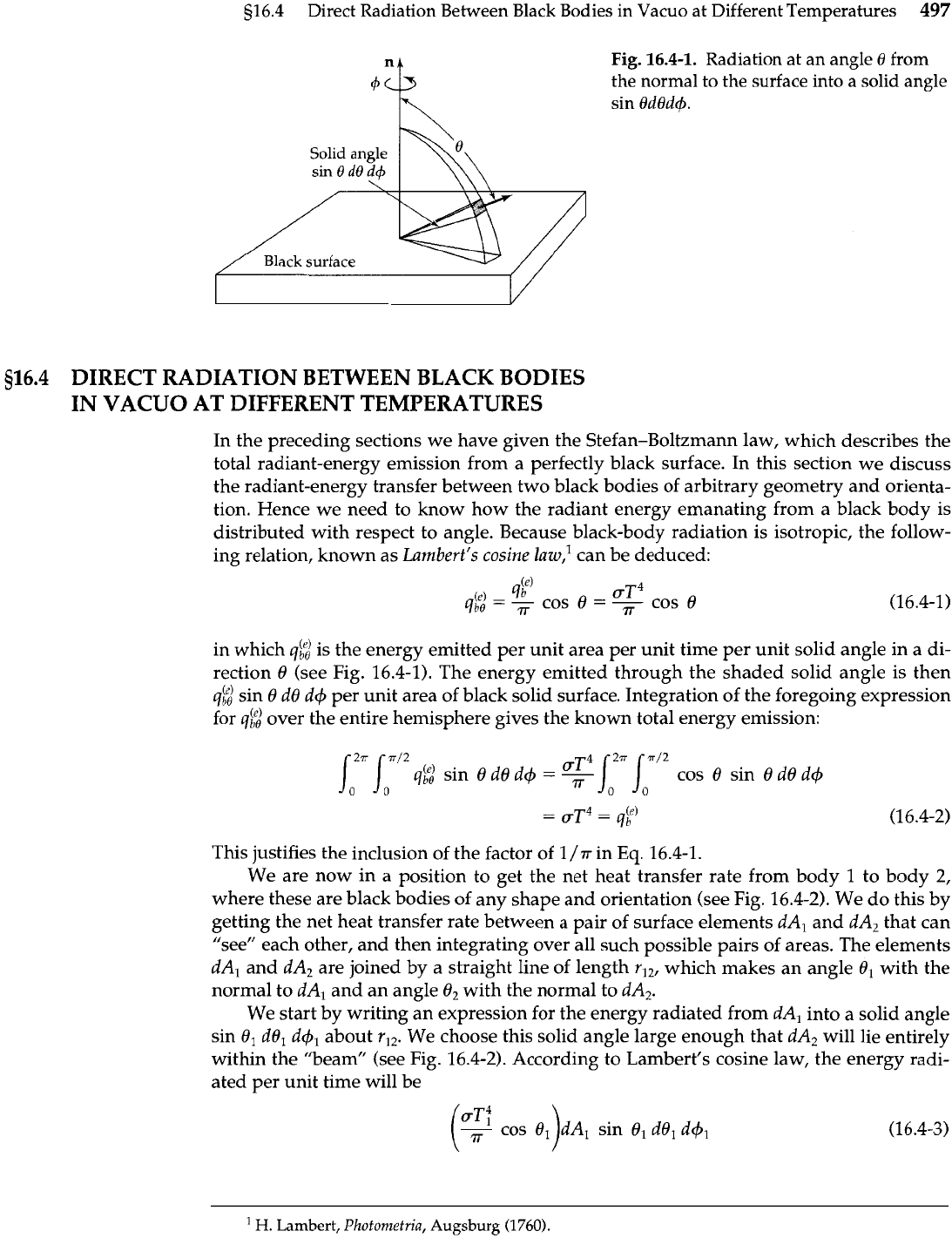
s16.4
Direct Radiation Between Black Bodies in Vacuo at Different Temperatures
497
Fig.
16.4-1.
Radiation at an angle
0
from
the normal to the surface into a solid angle
sin
8ddd4.
516.4
DIRECT RADIATION BETWEEN BLACK BODIES
IN VACUO AT DIFFERENT TEMPERATURES
In the preceding sections we have given the Stefan-Boltzmann law, which describes the
total radiant-energy emission from a perfectly black surface. In this section we discuss
the radiant-energy transfer between two black bodies of arbitrary geometry and orienta-
tion. Hence we need to know how the radiant energy emanating from a black body is
distributed with respect to angle. Because black-body radiation is isotropic, the follow-
ing relation, known as Lambert's cosine
law,'
can be deduced:
in which
qg
is the energy emitted per unit area per unit time per unit solid angle in a di-
rection
8
(see Fig. 16.4-1). The energy emitted through the shaded solid angle is then
qt
sin
8
de d+
per unit area of black solid surface. Integration of the foregoing expression
for
qfj
over the entire hemisphere gives the known total energy emission:
LZT
r
qf$
sin
e
ae
a+
=
,
uT4
/021
lo*/'
cos
B
sin
e
ae
d+
This justifies the inclusion of the factor of I/T in
Eq.
16.4-1.
We are now in a position to get the net heat transfer rate from body 1 to body 2,
where these are black bodies of any shape and orientation (see Fig. 16.4-2). We do this by
getting the net heat transfer rate between a pair of surface elements
dA,
and
dA,
that can
"see" each other, and then integrating over all such possible pairs
of
areas. The elements
dAl
and
dA2
are joined by a straight line of length r,,, which makes an angle 8, with the
normal to
dA,
and an angle
82
with the normal to dA,.
We start by writing an expression for the energy radiated from
dA,
into a solid angle
sin
O1
dB1 d+,
about r,,. We choose this solid angle large enough that
dA2
will lie entirely
within the "beam" (see Fig. 16.4-2). According to Lambert's cosine law, the energy radi-
ated per unit time will be
(9
cos B,)dA, sin
el
do,
d+,
'
H.
Lambert,
Photometria,
Augsburg
(1760).
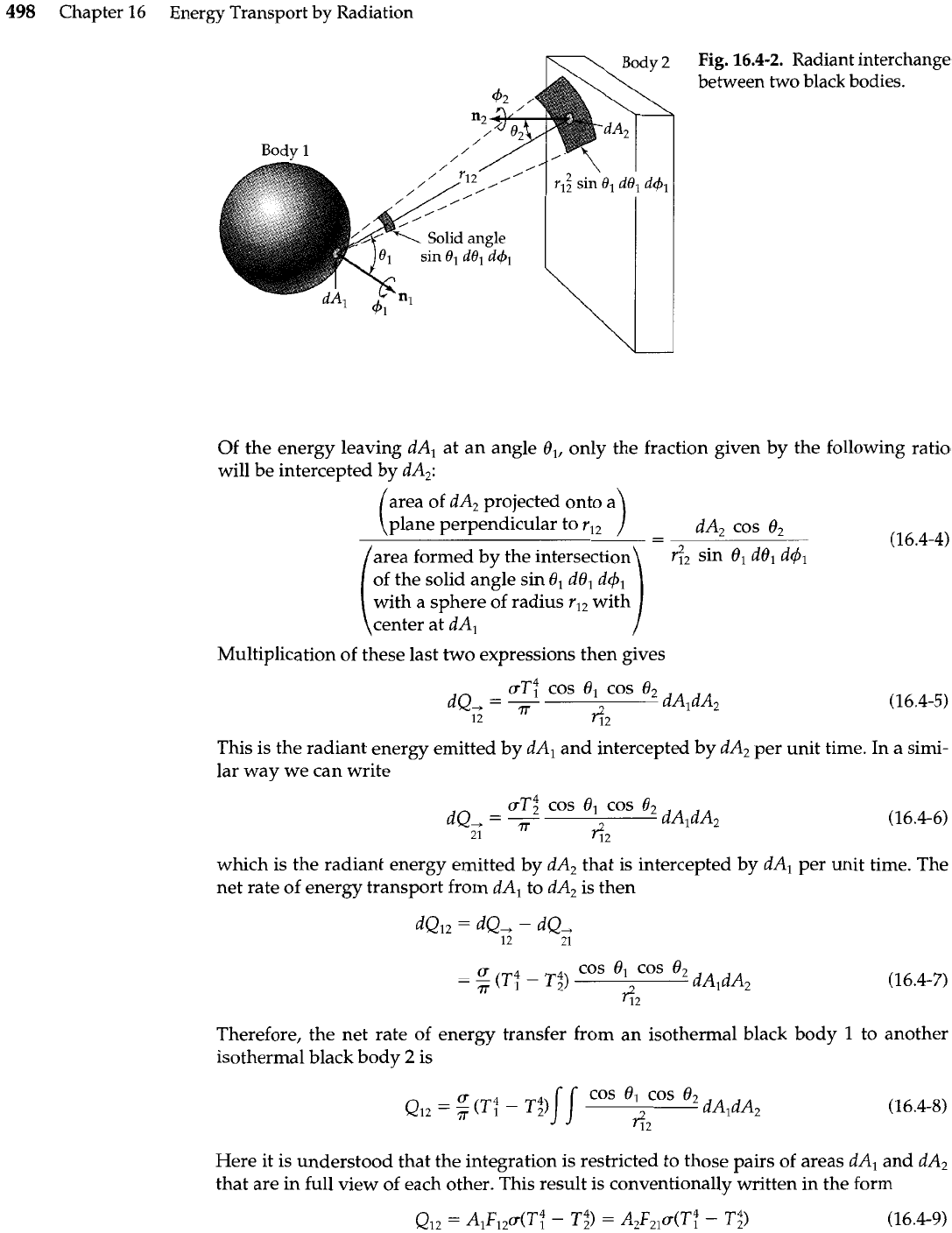
498
Chapter
16
Energy Transport by Radiation
Fig.
16.4-2.
Radiant interchange
between two black bodies.
Of the energy leaving
dAl
at an angle
O,,
only the fraction given by the following ratio
will be intercepted by
dA,:
area of
dA2
projected onto a
plane perpendicular to
r,,
-
dA2
cos
82
(16.4-4)
i
area formed by the
r:
sin
6,
dBl
d4,
of the solid angle sin
61
dO,
d+,
with a sphere of radius
r12
with
center at
dA,
Multiplication of these last two expressions then gives
This is the radiant energy emitted by
dA,
and intercepted by
dA,
per unit time. In
a
simi-
lar way we can write
UT;
cos
O1
cos
8,
dQ,
=
-
dAldA2
21
$2
which is the radiant energy emitted by
dA2
that is intercepted by
dA,
per unit time. The
net rate of energy transport from
dA,
to
dA2
is then
Therefore, the net rate of energy transfer from an isothermal black body
1
to another
isothermal black body
2
is
Here it is understood that the integration is restricted to those pairs of areas
dA,
and
dA2
that are in full view of each other. This result is conventionally written in the form

g16.4
Direct Radiation Between Black Bodies in Vacuo at Different Temperatures
499
0.1
0.2 0.30.4 0.6 1.0 2 34 6 10-
z
Dimension ratio
-
X
Fig.
16.4-3.
View factors for direct radiation between adjacent rectangles in perpendicular planes
[H.
C.
Hottel, Chapter
3
in
W.
H.
McAdams,
Heat
Transmission, McGraw-Hill, New York (1954), p.
681.
where A, and A2 are usually chosen to be the total areas of bodies
1
and
2.
The dimen-
sionless quantities F,, and F,,, called
view
factors (or angle factors or configuration factors),
are given by
and the two view factors are related by A,F,,
=
A,F,,. The view factor
F,,
represents the
fraction of radiation leaving body 1 that its directly intercepted by body
2.
The actual calculation of view factors is a difficult problem, except for some very
simple situations. In Fig. 16.4-3 and Fig. 16.4-4 some view factors for direct radiation are
sh~wn.~,~,When such charts are available, the calculations of energy interchanges by Eq.
16.4-9 are easy.
In the above development, we have assumed that Lambert's law and the
Stefan-Boltzmann law may be used to describe the nonequilibrium transport process, in
spite of the fact that they are strictly valid only for radiative equilibrium. The errors thus
introduced do not seem to have been studied thoroughly, but apparently the resulting
formulas give a good quantitative description.
H.
C.
Hottel and
A.
F.
Sarofim,
Radiative Transfer,
McGraw-Hill, New York
(1967).
H.C.
Hottel, Chapter
4
in
W.
H.
McAdams,
Heat Transmission,
McGraw-Hill, New York
(1954).
'
R.
Siege1 and
J.
R.
Howell,
Thermal Radiation Heat Transfer,
3rd edition, Hemisphere Publishing Co.,
New York
(1992).
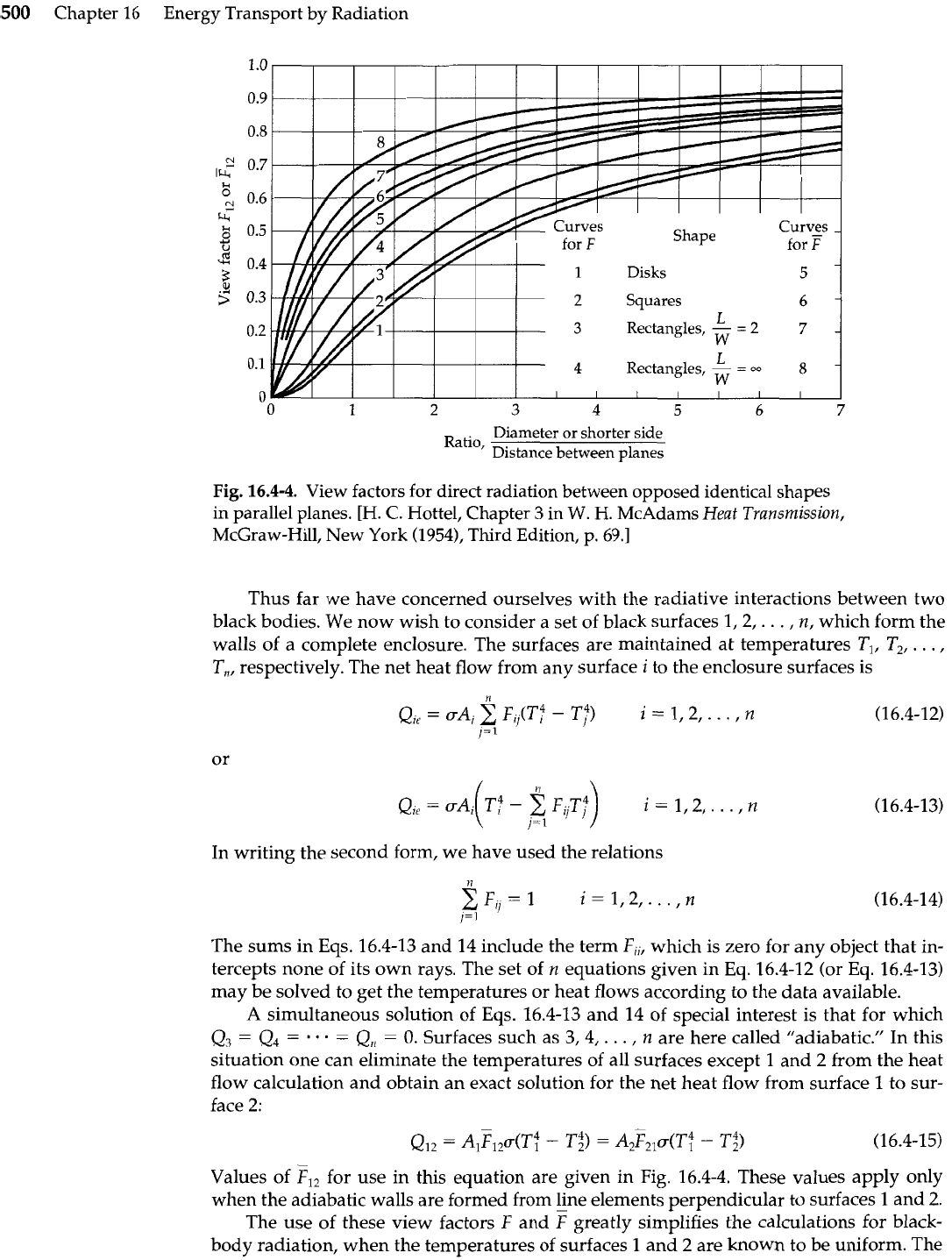
500
Chapter 16 Energy Transport by Radiation
Diameter or shorter side
Ratio,
Distance between planes
Fig.
16.4-4.
View factors for direct radiation between opposed identical shapes
in
parallel planes.
[H.
C.
Hottel, Chapter
3
in
W.
H. McAdams
Heat
Transmission,
McGraw-Hill, New York (1954), Third Edition, p. 69.1
Thus far we have concerned ourselves with the radiative interactions between two
black bodies. We now wish to consider a set of black surfaces 1,2,
. .
.
,
n, which form the
walls of a complete enclosure. The surfaces are maintained at temperatures
TI, T,,
.
.
.
,
T,,
respectively. The net heat flow from any surface
i
to the enclosure surfaces is
n
Q,,
=
UA,~
F,,(Tf
-
T$)
i
=
1,2,.
.
.
,n
(16.4-12)
]=I
In writing the second form, we have used the relations
The sums in Eqs. 16.4-13 and 14 include the term F,,, which is zero for any object that in-
tercepts none of its own rays. The set of
n
equations given in Eq. 16.4-12 (or Eq. 16.4-13)
may be solved to get the temperatures or heat flows according to the data available.
A
simultaneous solution of Eqs. 16.4-13 and 14 of special interest is that for which
Q&
-Q
4=...=
7
-
Q,
=
0.
Surfaces such as 3,4,
.
.
.
,
n
are here called "adiabatic." In this
situation one can eliminate the temperatures of all surfaces except 1 and 2 from the heat
flow calculation and obtain an exact solution for the net heat flow from surface
1
to sur-
face 2:
Values of F,, for use in this equation are given in Fig. 16.4-4. These values apply only
when the adiabatic walls are formed from line elements perpendicular to surfaces 1 and
2.
The use of these view factors
F
and
T
greatly simplifies the calculations for black-
body radiation, when the temperatures of surfaces 1 and 2 are known to be uniform. The
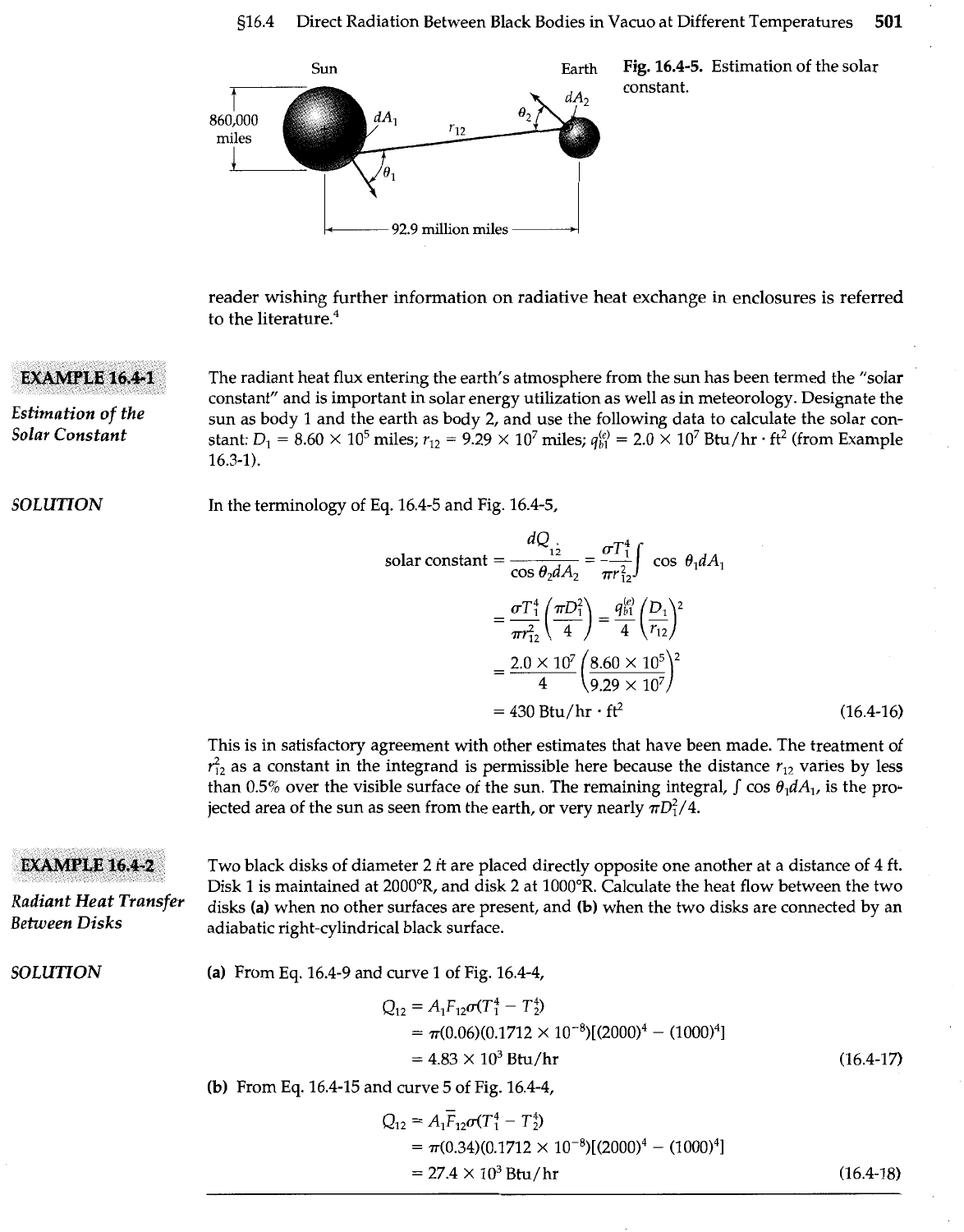
516.4
Direct Radiation Between Black Bodies in Vacuo at Different Temperatures
501
Sun
Earth
Fig.
16.4-5.
Estimation of the solar
constant.
1-
92.9
million miles
reader wishing further information on radiative heat exchange in enclosures
is
referred
to the literat~re.~
The radiant heat flux entering the earth's atmosphere from the sun has been termed the "solar
constant" and is important in solar energy utilization as well as
in
meteorology. Designate the
Estimation of the
sun as body 1 and the earth as body 2, and use the following data to calculate the solar con-
Solar Constant
stant: Dl
=
8.60
X
lo5
miles;
rI2
=
9.29
X
lo7
miles;
qfi)
=
2.0
X
lo7
Btu/hr. ft2 (from Example
16.3-1).
SOLUTION
In the terminology of
Eq.
16.4-5 and Fig. 16.4-5,
dQ
,
solar constant
=
cos O1dAl
This is in satisfactory agreement with other estimates that have been made. The treatment of
r:, as a constant in the integrand is permissible here because the distance
r12
varies by less
than 0.5% over the visible surface of the sun. The remaining integral,
$
cos B,dA,, is the proL
jected area of the sun as seen from the earth, or very nearly .rrJ3:/4.
Two black disks of diameter
2
ft
are placed directly opposite one another at a distance of 4 ft.
Disk 1 is maintained at 2000°R, and disk
2
at 1000°R. Calculate the heat flow between the two
Radiant
Heat
Transfer
disks
(a)
when no other surfaces are present, and
(b)
when the two disks are connected by an
Between Disks
adiabatic right-cylindrical black surface.
SOLUTION
(a)
From
Eq.
16.4-9 and curve 1 of Fig. 16.4-4,
Q12
=
A1F7p(T?
-
T;)
=
~(0.06)(0.1712
X
10-~)[(2000)~
-
(~ooo)~]
=
4.83
x
lo3
Btu/hr
(b)
From Eq. 16.4-15 and curve 5 of Fig. 16.4-4,
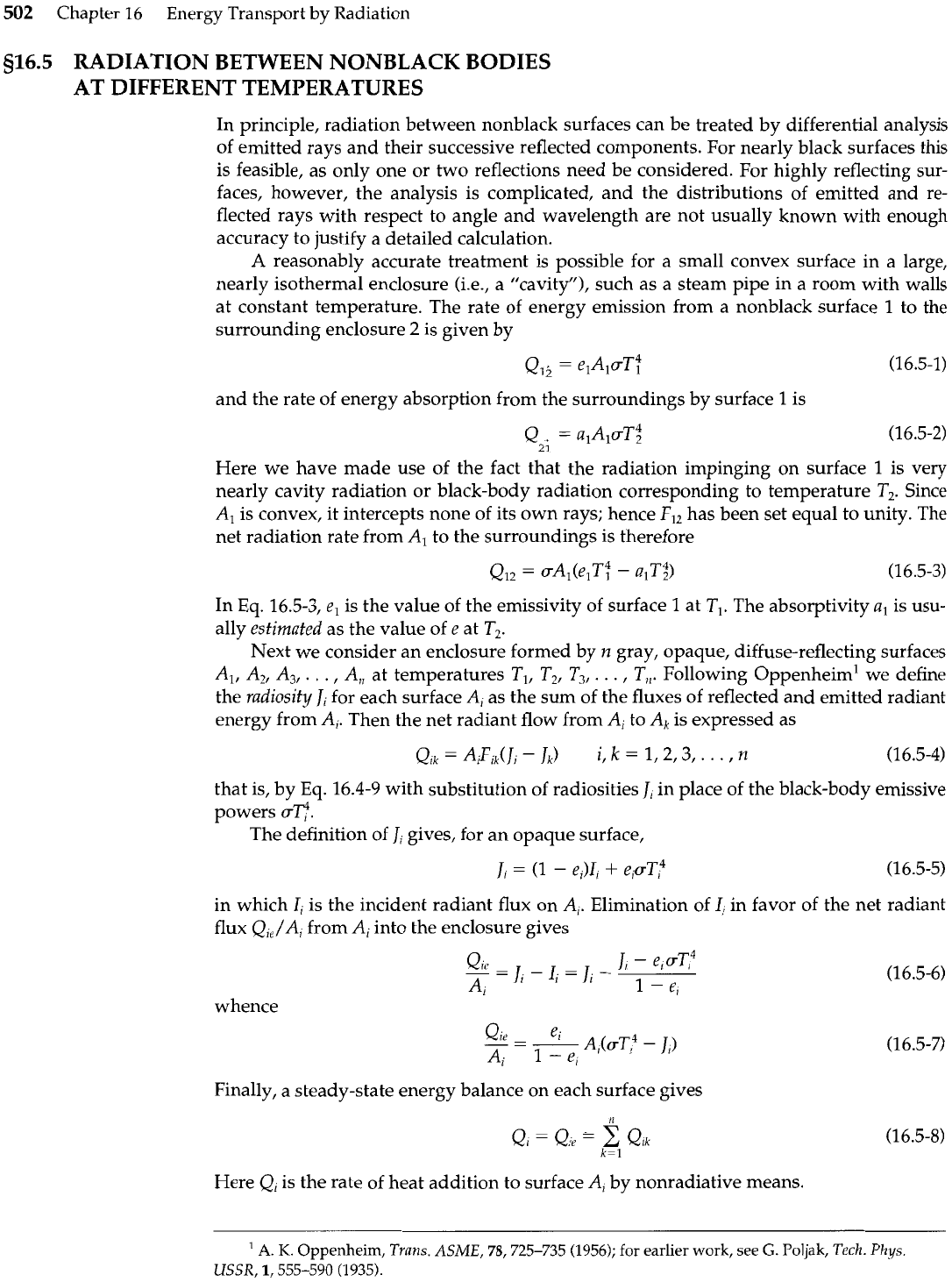
502
Chapter
16
Energy Transport by Radiation
s16.5
RADIATION BETWEEN NONBLACK BODIES
AT DIFFERENT TEMPERATURES
In principle, radiation between nonblack surfaces can be treated by differential analysis
of emitted rays and their successive reflected components. For nearly black surfaces this
is feasible, as only one or two reflections need be considered. For highly reflecting sur-
faces, however, the analysis is complicated, and the distributions of emitted and re-
flected rays with respect to angle and wavelength are not usually known with enough
accuracy to justify a detailed calculation.
A
reasonably accurate treatment is possible for a small convex surface in a large,
nearly isothermal enclosure (i.e., a "cavity"), such as a steam pipe in a room with walls
at constant temperature. The rate of energy emission from a nonblack surface 1 to the
surrounding enclosure
2
is given by
and the rate of energy absorption from the surroundings by surface 1 is
Here we have made use of the fact that the radiation impinging on surface 1 is very
nearly cavity radiation or black-body radiation corresponding to temperature T,. Since
A, is convex, it intercepts none of its own rays; hence
F,,
has been set equal to unity. The
net radiation rate from A, to the surroundings is therefore
1
S
usu-
In Eq. 16.5-3,
e,
is the value of the emissivity of surface
1
at TI. The absorptivity
a
i
ally
estimated
as the value of
e
at
T,.
Next we consider an enclosure formed by
n
gray, opaque, diffuse-reflecting surfaces
A,, A,, A3,.
.
.
,
A,,
at temperatures TI,
T,,
T,,
. . .
,
T,. Following oppenheiml we define
the
radiosity
Ji
for each surface A, as the sum of the fluxes of reflected and emitted radiant
energy from Ai. Then the net radiant flow from Ai to A, is expressed as
that is, by Eq. 16.4-9 with substitution of radiosities
J,
in place of the black-body emissive
powers
ac.
The definition of
Ji
gives, for an opaque surface,
in which
li
is the incident radiant flux on A,. Elimination of
li
in favor of the net radiant
flux Qi,/Ai from Ai into the enclosure gives
whence
Finally, a steady-state energy balance on each surface gives
Here Q, is the rate of heat addition to surface A, by nonradiative means.
'
A.
K.
Oppenheim,
Tmns.
ASME,
78,725-735
(1956);
for earlier work, see
G.
Poljak,
Tech.
Phys.
USSR,
1,555-590 (1935).
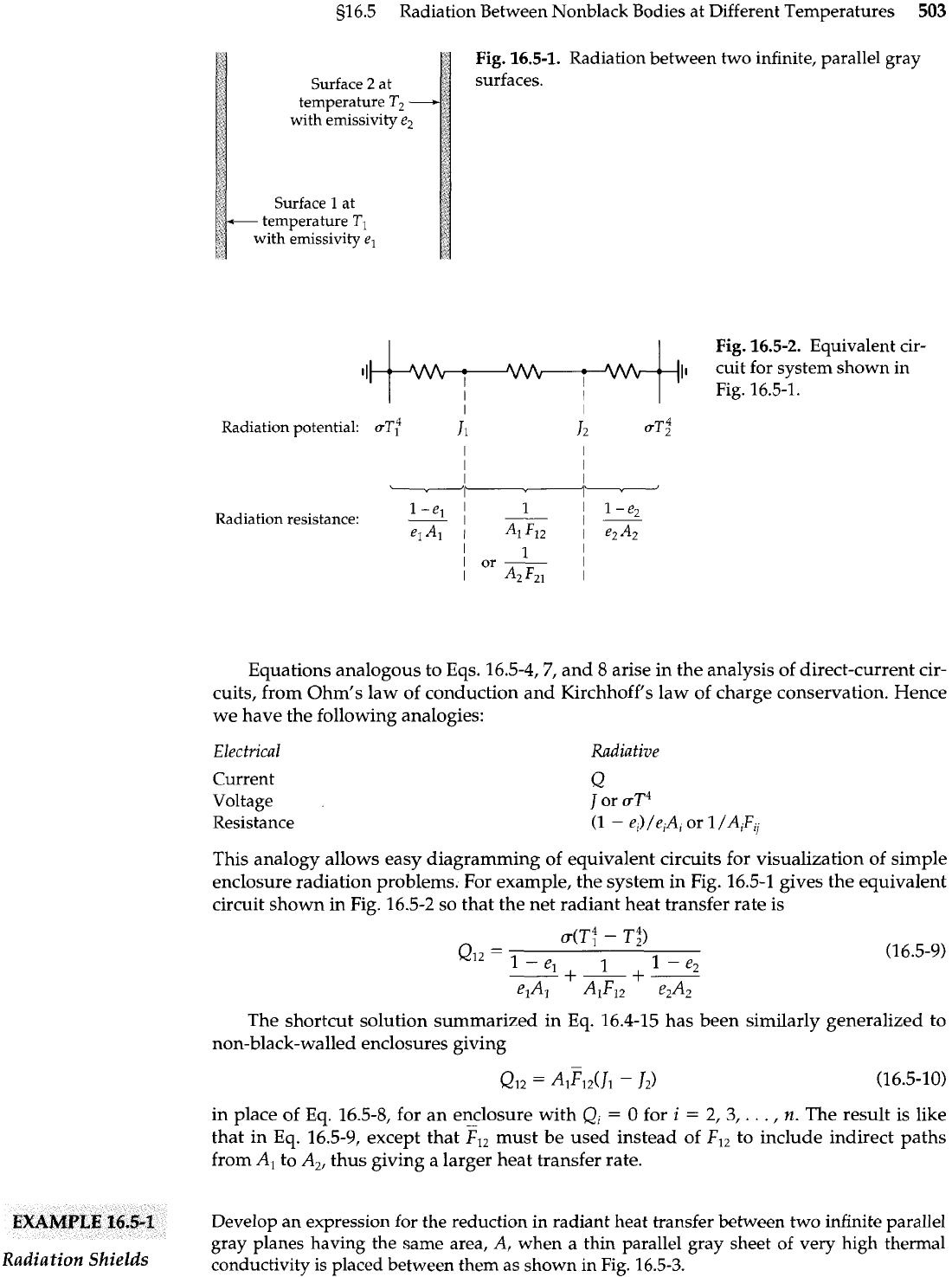
g16.5 Radiation Between Nonblack Bodies at Different Temperatures
503
Fig.
16.5-1.
Radiation between two infinite, parallel gray
Surface
2
at
surfaces.
temperature
T2
with emissivity
e2
Surface
1
at
temperature
TI
with emissivity
el
Radiation potential:
UT~
h
h
CTT;
~I~~
=
I
-
I*
I
I
I-el
I
1
I
1-ez
Radiation resistance:
-1
-
I
-
elAl
I
A1F12
I
e2-42
I
1
I
I
or
-
I
I
A2F21
I
Fig.
16.5-2.
Equivalent cir-
dll
cuit for system shown in
Fig. 16.5-1.
Equations analogous to Eqs. 16.5-4,7, and
8
arise in the analysis of direct-current cir-
cuits, from Ohm's law of conduction and Kirchhoff's law of charge conservation. Hence
we have the following analogies:
I
I
Electrical
Current
Voltage
Resistance
Radiative
This analogy allows easy diagramming of equivalent circuits for visualization of simple
enclosure radiation problems. For example, the system in Fig. 16.5-1 gives the equivalent
circuit shown in Fig. 16.5-2 so that the net radiant heat transfer rate is
The shortcut solution summarized in
Eq.
16.4-15 has been similarly generalized to
non-black-walled enclosures giving
in place of Eq. 16.5-8, for an enclosure with
Qi
=
0
for
i
=
2,
3,.
.
.
,
n.
The result is like
that in Eq. 16.5-9, except that
F1,
must be used instead of
F1,
to include indirect paths
from
A,
to A,, thus giving
a
larger heat transfer rate.
Develop an expression for the reduction in radiant heat transfer between two infinite parallel
gray planes having the same area, A, when a thin parallel gray sheet of very high thermal
Radiation
Shields
conductivity is placed between them as shown in Fig. 16.5-3.
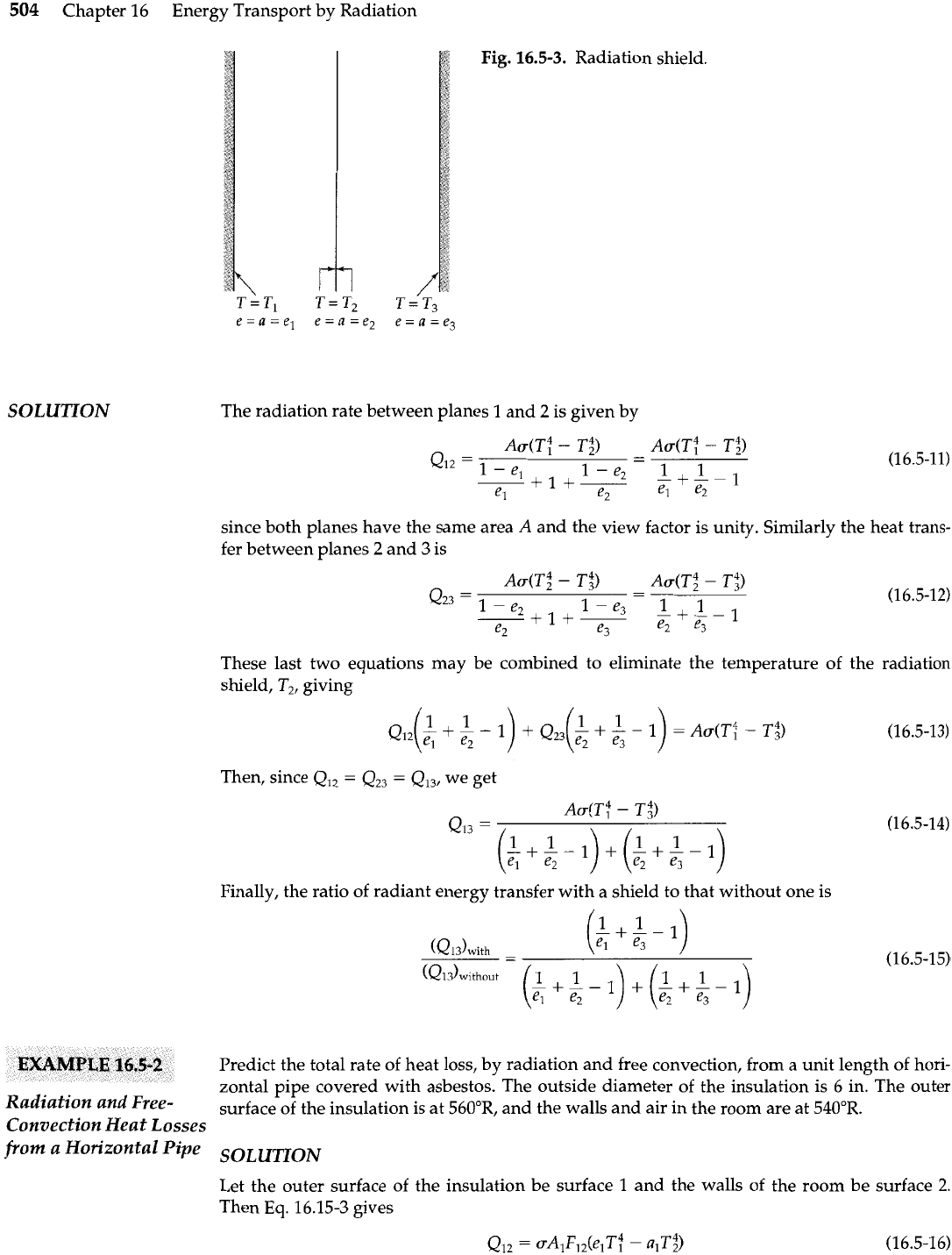
504
Chapter 16 Energy Transport by Radiation
SOLUTION
Fig.
16.5-3.
Radiation shield.
The radiation rate between planes
1
and
2
is given by
since both planes have the same area
A
and the view factor is unity. Similarly the heat trans-
fer between planes
2
and 3 is
These last two equations may be combined to eliminate the temperature of the radiation
shield, T,, giving
Then, since
Q,,
=
Q2,
=
Q,,, we get
Finally, the ratio of radiant energy transfer with a shield to that without one is
EXAMPLE
16.5-2
Radiation and
Free-
Convection Heat Losses
from a Horizontal Pipe
Predict the total rate of heat loss, by radiation and free convection, from a unit length of hori-
zontal pipe covered with asbestos. The outside diameter of the insulation is 6 in. The outer
surface of the insulation is at 560°R, and the walls and air in the room are at 540°R.
SOLUTION
Let the outer surface of the insulation be surface
1
and the walls of the room be surface
2.
Then
Eq.
16.15-3 gives
Q12
=
4Fl2(e1T?
-
4T;)
(16.5-16)
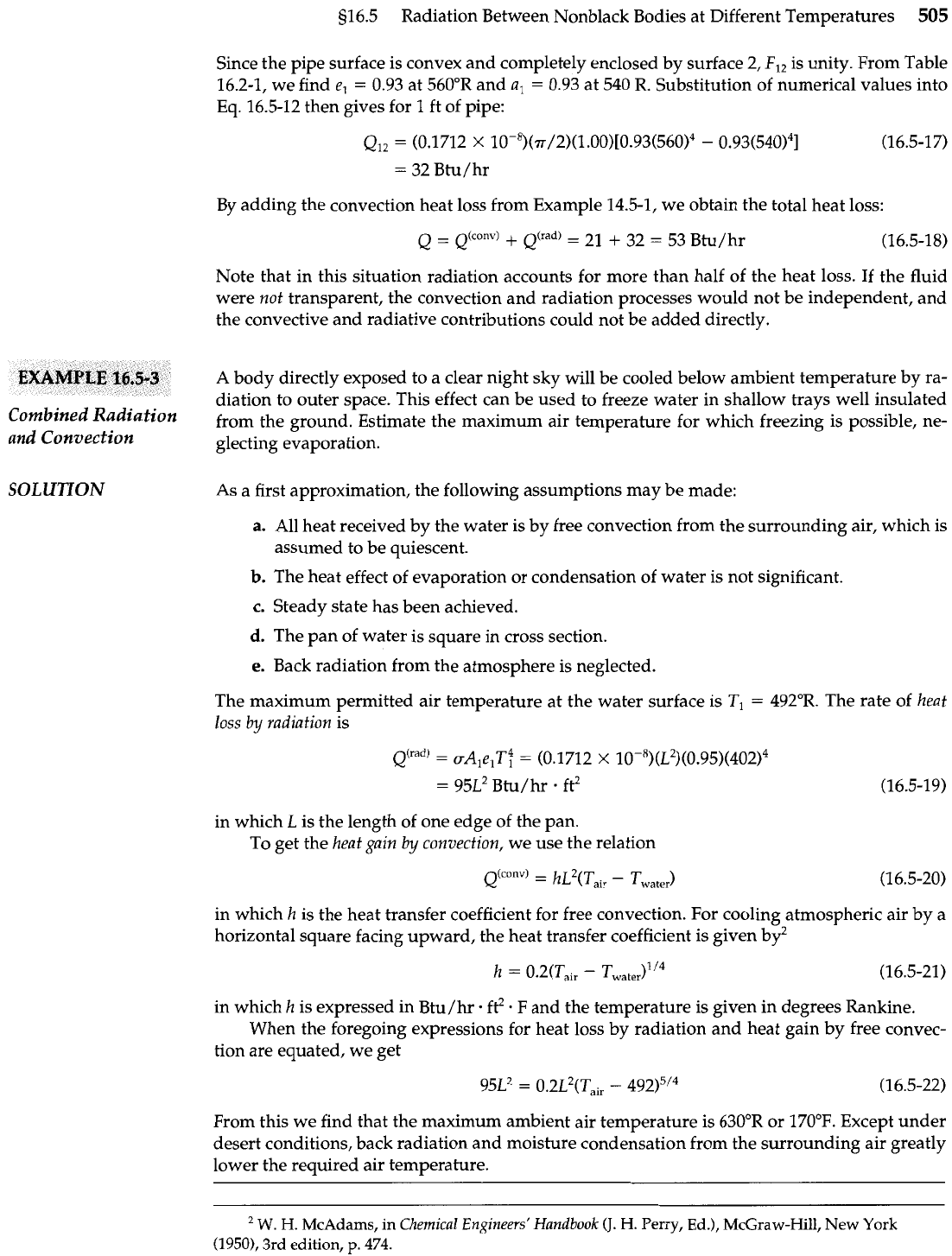
g16.5 Radiation Between Nonblack Bodies at Different Temperatures
505
Since the pipe surface is convex and completely enclosed by surface
2,
F,,
is unity. From Table
16.2-1, we find e,
=
0.93 at 560"R and a,
=
0.93 at 540 R. Substitution of numerical values into
Eq.
16.5-12 then gives for
1
ft of pipe:
By adding the convection heat loss from Example 14.5-1, we obtain the total heat loss:
Note that in this situation radiation accounts for more than half of the heat loss. If the fluid
were not transparent, the convection and radiation processes would not be independent, and
the convective and radiative contributions could not be added directly.
A body directly exposed to a clear night sky will be cooled below ambient temperature by ra-
diation to outer space. This effect can be used to freeze water in shallow trays well insulated
Combined
Radiation
from the ground. Estimate the maximum air temperature for which freezing is possible, ne-
and
Convection
glecting evaporation.
SOLUTION
As a first approximation, the following assumptions may be made:
a.
All heat received by the water is by free convection from the surrounding air, which is
assumed to be quiescent.
b.
The heat effect of evaporation or condensation of water is not significant.
c.
Steady state has been achieved.
d.
The pan of water is square in cross section.
e.
Back radiation from the atmosphere is neglected.
The maximum permitted air temperature at the water surface is
T,
=
492"R. The rate of heat
loss
by
radiation is
in which
L
is the length of one edge of the pan.
To get the heat gain
by
convection, we use the relation
in which
h
is the heat transfer coefficient for free convection. For cooling atmospheric air by
a
horizontal square facing upward, the heat transfer coefficient is given by2
in
which h is expressed in Btu/hr. ft2.
F
and the temperature is given in degrees Rankine.
When the foregoing expressions for heat loss by radiation and heat gain by free convec-
tion are equated, we get
95L2
=
0.2L2(Tair
-
492)5/4 (16.5-22)
From this we find that the maximum ambient air temperature is 630°R or 170°F. Except under
desert conditions, back radiation and moisture condensation from the surrounding air greatly
lower the required air temperature.
W.
H.
McAdams,
in
Chemical Engineers' Handbook
(J.
H.
Perry,
Ed.),
McGraw-Hill, New York
(1950),
3rd
edition,
p.
474.
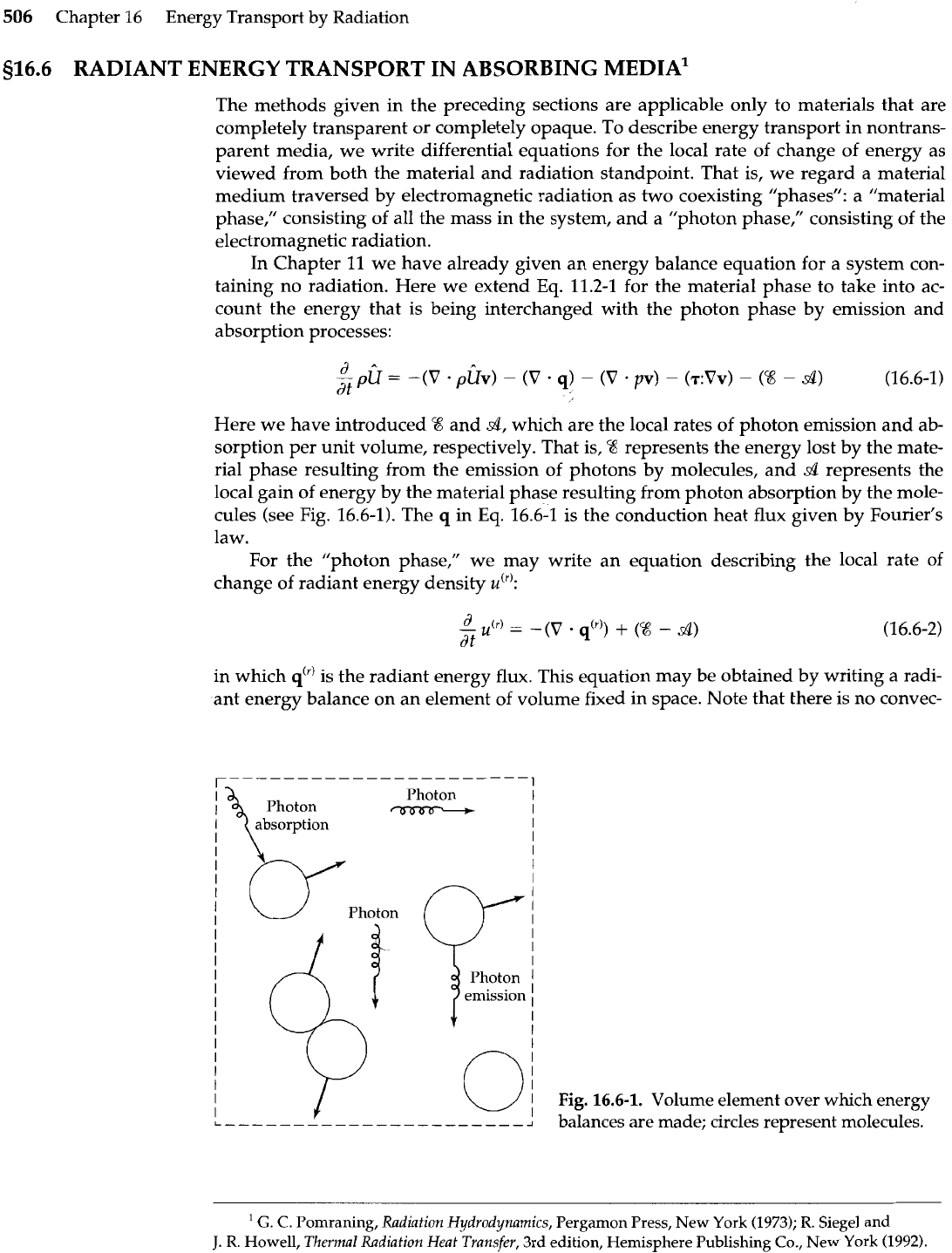
506
Chapter 16 Energy Transport by Radiation
516.6
RADIANT ENERGY TRANSPORT
IN
ABSORBING MEDIA3
The methods given in the preceding sections are applicable only to materials that are
completely transparent or completely opaque. To describe energy transport in nontrans-
parent media, we write differential equations for the local rate of change of energy as
viewed from both the material and radiation standpoint. That is, we regard a material
medium traversed by electromagnetic radiation as two coexisting "phases": a "material
phase," consisting of all the mass in the system, and a "photon phase," consisting of the
electromagnetic radiation.
In Chapter 11 we have already given an energy balance equation for a system con-
taining no radiation. Here we extend Eq. 11.2-1 for the material phase to take into ac-
count the energy that is being interchanged with the photon phase by emission and
absorption processes:
Here we have introduced
%
and
d,
which are the local rates of photon emission and ab-
sorption per unit volume, respectively. That is,
%
represents the energy lost by the mate-
rial phase resulting from the emission of photons by molecules, and
d
represents the
local gain of energy by the material phase resulting from photon absorption by the mole-
cules (see Fig. 16.6-1). The
q
in Eq. 16.6-1 is the conduction heat flux given by Fourier's
law.
For the "photon phase," we may write an equation describing the local rate of
change of radiant energy density
dr':
in which
q"'
is the radiant energy flux. This equation may be obtained by writing a radi-
ant energy balance on an element of volume fixed in space. Note that there is no convec-
I
Photon
1
-
I
I
I
L/)
Photon
I
Photon
I
I
emission
I
I
I
I
I
I
I
I
Fig.
16.6-1.
Volume element over which energy
I
- - - -
-
-
- - -
-
- - - - -
- - -
- - - -
A
balances are made; circles represent molecules.
G. C.
Pomraning,
Radiation Hydrodynamics,
Pergamon Press, New York (1973);
R.
Siege1 and
J.
R.
Howell,
Themzal Radiation Heat Transfer,
3rd edition, Hemisphere Publishing Co., New York (1992).
